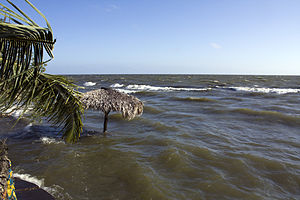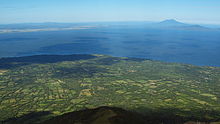Lake Nicaragua
| Lake Nicaragua | ||
|---|---|---|

|
||
| Lake Nicaragua | ||
| Geographical location | Nicaragua | |
| Tributaries | Río Tipitapa | |
| Drain | Río San Juan | |
| Places on the shore | Granada , Rivas , San Carlos , San Miguelito | |
| Data | ||
| Coordinates | 11 ° 36 '32 " N , 85 ° 21' 3" W | |
|
|
||
| Altitude above sea level | 31 m | |
| surface | 8,157 km² | |
| Maximum depth | 45 m | |
| Middle deep | 13 m | |
|
particularities |
largest lake in Central America |
|
Lake Nicaragua (Spanish: Lago de Nicaragua ), also known as Cocibolca , is the largest inland lake in Central America and is located in the southwest of Nicaragua near the state border with Costa Rica .
geography
With an area of 8,157 square kilometers, Lake Nicaragua is the third largest lake in Latin America after Lake Maracaibo and Lake Titicaca . If you take into account that Lake Maracaibo is an inland sea , Lake Nicaragua is the second largest lake in Latin America.
In the north it is connected to Lake Managua via the Río Tipitapa .
There are more than 400 islands in the lake , the largest being Zapatera in the north and Ometepe in the middle of the lake. Ometepe consists of two volcanoes, the Concepción volcano at 1,610 m and the Maderas volcano at 1,340 m. Eruptions of both volcanoes have led to the fact that the originally two islands have merged into a single island due to the lava flows. Prehistoric stone statues and petroglyphs can also be found here . Perhaps the most famous group of islands are the Solentiname Islands in the south of the lake, where Ernesto Cardenal lived for a long time.
The lake is an important traffic artery: numerous ferries connect a number of coastal towns and the inhabited islands with one another. Time and again there have been and are considerations to establish a connection between the Pacific and Atlantic via Lake Nicaragua - the Nicaragua Channel . However, this would mean that the lake would gradually change from a freshwater to a saltwater lake through the connection to the two oceans. Critics of the canal project fear an ecological catastrophe.
fauna
In Nicaragua live including several cichlid, namely lemon cichlid ( Amphilophus citrinellus ) and A. labiatus , the convict cichlid ( Amatitlania nigrofasciata ) Archocentrus centrarchus , the rainbow cichlid ( Herotilapia multispinosus ) Cribroheros longimanus and C. rostratum , Cryptoheros spilurus , the Nicaragua cichlid ( Hypsophrys nicaraguensis ), Neetroplus nematopus , Parachromis dovii , P. loisellei , P. managuense and Vieja maculicauda and, as large predatory fish, the bull shark and the Atlantic tarpon .
mythology
According to legend, the islands of Ometepe and Zapatera as well as Lake Nicaragua emerged from a tragic love story: this is how the respected Nagrando fell in love with the beautiful chief daughter of a neighboring tribe called Ometeptl . Both Indian tribes, however, were at odds over territorial claims and power issues. According to ancestral law, love between warring tribes was forbidden. The couple therefore soon had to flee their home villages and hid in a valley. However, since their love was not kept secret, they were persecuted by their tribesmen. Finally, out of desperation, both decided to commit suicide and opened their wrists. Ometeptl fell backwards, Nagrando stumbled a few more steps and fell down too. The blood of both filled the valley and covered their bodies - today's Lake Nicaragua. Of Ometeptl's body, only her breasts protrude above the water level, today's volcanoes Concepción and Maderas. From the body of Nagrando, one can only see, a little further away, the tips of the island of Zapatera .
Web links
Individual evidence
- ↑ a b Lake profile - Cocibolca (Nicaragua). LakeNet, accessed February 25, 2008 .
- ↑ The Cichlids of Lake Nicaragua
- ^ Leonard JV Compagno : FAO Species Catalog, Vol. 4 Sharks of the World An Annotated and Illustrated Catalog of Shark Species Known to Date, Part 2 - Carcharhiniformes. FAO Fisheries Synopsis No. 125, Volume 4, Part 2, page 479
- ↑ Megalops atlanticus on Fishbase.org (English)
- ↑ Archived copy ( Memento of the original from April 18, 2012 in the Internet Archive ) Info: The archive link was inserted automatically and has not yet been checked. Please check the original and archive link according to the instructions and then remove this notice.


